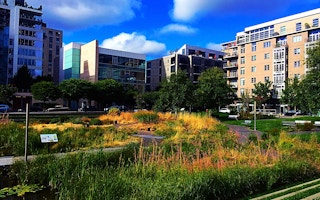The downtown Pearl District is among the hottest housing markets in this booming Pacific Northwest city. But a one-block parcel that surely could have fetched millions of dollars if sold to a real estate developer remains an oasis of calm, a wild wetland with freshly designed paths and benches. The grass after a wet winter squishes underfoot, and water trickles gently downhill into a retaining pond.
Tanner Springs Park is a tiny remnant of what was once a large wetland and lake, collecting the water that cascades down from the hills lacing Portland’s western edge. The park was conceived in a 1999 master plan for the Pearl District, a bustling collection of high-end condos and apartments, chic boutiques, and purveyors of the artisanal food and spirits that have made this city a gastronomic destination.
This ecological design approach in the heart of downtown made Portland a fitting host for a 26 April discussion about the role of nature in cities. Hosted by David Maddox, editor of the Nature of Cities blog, and sponsored by the Bullitt Foundation, which supports environmental causes in the region, the daylong symposium at the Portland Zoo — itself a major conservation organisation — featured leading voices on ecological urbanism from six continents.
Artists, architects, planners, designers and ecologists all took the stage to share their vision of how to better integrate nature into cities. Here are five big ideas from the talks.
1. Be “biophilic”
Conservationist E. O. Wilson coined the term “biophilia” in 1984 as “the urge to affiliate with other forms of life”. But if cities are the apotheosis of human settlements, too often they crowd out those other forms of life. And even when cities are well-designed for humans, that doesn’t mean they are kind to other flora and fauna. “Livability has nothing to do with success as an ecological city,” scoffed Australian environmental urbanist Paul Downton.
Enter the biophilic city, one that creates a home for more than just humans. The biophilic city would include a set of design guidelines for non-humans. For example, a city could be required to have sufficient viable habitat to support at least one key indicator species of fauna and a majority of the species of birds indigenous to the place.
2. Co-opt infrastructure
Building the world’s bridges, tunnels, roads and railways has long been the purview of civil engineers, whose primary goal of structural integrity at times can be at odds with natural systems. For example, the most sure-fire way to anchor a bridge may involve driving concrete pylons deep into a riverbed — but what if that approach would disrupt fish migratory patterns?
For Nina-Marie Lister, who teaches urban and regional planning at Ryerson University in Toronto, the answer is to reclaim the term. “How can we co-opt the word ‘infrastructure’ to make better decisions about the landscapes that sustain us?” she asked. Green-roof bylaws in Toronto and Chicago are one example of infrastructure that treats nature as an integral component rather than an afterthought. Innovative designs for wildlife bridges that give priority to animals over cars likewise landed on the cover of business magazine Fast Company.
3. Leverage climate change
In the developing world, nature and growth are often at odds. Ugandan geographer Shuaib Lwasa lamented how his home town of Kampala sees new construction as the best course of action, whatever the environmental impact. “The attitudes toward urban conservation in Africa are very poor,” he said.
But where introducing nature into the city was once seen as an expendable beautification effort, the new urgency of climate change has provided a stronger rationale. For example, Kampala is planting 500,000 trees — a classic beautification project — under the guise of its new climate change action plan. What prompted the switch in strategy? Because climate change is now a source of development aid for cities: In this case, the European Union is footing the bill for those new seedlings.
4. Consider gender
When the UN Food and Agriculture Organization wanted to encourage the planting of vegetable gardens in Nicaraguan informal settlements, the idea seemed like a no-brainer. Gardens would help with food security and nutrition concerns. While the men in the households involved in the initiative were all in favour, the women were more hesitant. Why the trepidation? Planting vegetable gardens would require chopping down fruit trees that provide much-needed privacy around the outdoor patios where women do their housework.
This anecdote is a cautionary tale of what Montréal-based scholar Laura Shillington called “the gendered impact of environmental issues”. Just as advocates believe that gender should be taken into consideration when planning a transportation line, building new housing or allocating municipal resources, the same should be the case with environmental urbanism. As Shillington said, “Nature in cities can challenge uneven relations if we think about gender seriously.”
5. Watch out for populism
If big corporations and industrial polluters were once the foes of the environmental movement, now the pendulum has shifted dramatically to a working-class grass roots swayed by the populist rhetoric that is quickly shaking the world to its foundation. Many of those disenfranchised former industrial workers now see talk of “urban sustainability” as a threat to their property rights and way of life.
“We underestimate how much local-scale decision-making is often at odds with global-scale sustainability efforts,” warned UN-Habitat’s Andrew Rudd. He called the conspiracy-theory pushback against the UN’s Agenda 21 “a cautionary tale worth remembering” especially as the New Urban Agenda, adopted last year, gains steam.
“
If big corporations and industrial polluters were once the foes of the environmental movement, now the pendulum has shifted dramatically to a working-class grass roots swayed by the populist rhetoric that is quickly shaking the world to its foundation.
Even though a goal of both voluntary, non-binding agreements was to encourage countries to devolve power to the local level, “There was a swell of opposition to any kind of UN agenda and the misperception that cooperation was somehow a direct threat to local determination.”
Gregory Scruggs is Senior Correspondent at Citiscope. This story was published with permission from Citiscope.org, a nonprofit news outlet that covers innovations in cities around the world. More at Citiscope.org.











